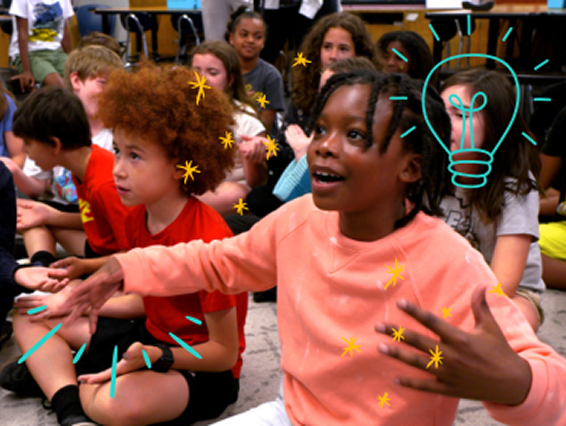A Simple Tool to Help Teachers Regulate Their Emotions
In a year that’s bringing a lot of stress, this tool is no cure-all, but it can help teachers keep their emotions in check.
Your content has been saved!
Go to My Saved Content.I remember my first year of teaching being difficult and then each subsequent year getting easier as I improved at the job. But now, for many educators, each year is getting more difficult to navigate, and the emotional toll is devastating.
The reports of educators teaching through trauma and instructional leaders tending to the business of supporting their schools under drastically unfavorable conditions aren’t going away, unfortunately, anytime soon.
On Twitter and the news, we can see daily reports of kids acting out, teachers not OK, revolving student quarantines, educators either quitting or being fired because of disputes over masks, and intense school board meetings. There have even been violent threats to school officials and teachers.
In my work with schools, there’s a lot of talk about the abovementioned issues and using emotion regulation strategies to combat the toll of the emotional pain that many educators are undoubtedly experiencing. Although social and emotional learning (SEL) strategies can be critical to restoring our own emotional health under chaotic conditions, it’s important to remember that emotional regulation strategies are not a panacea for the problems and issues facing our schools today—especially those out of our control.
However, neglecting our emotions over time may trigger excessive anxiety and cause apprehension, irritability, or anger. Some may withdraw socially or engage others negatively as a result. Not only can our mood be disrupted, but so can other aspects of life if we do not cope and heal by working through emotional exhaustion due to the buildup of stressors. Unfortunately, many in our profession are living with this.
In an episode of Queen Sugar (one of my favorite shows), a main character, Micah West, said, “I can’t control what happens, but I can control how to respond to things.” I think this is an empowering outlook—even in the most discouraging of times facing schools.
In a previous article, I covered using Plutchik’s Wheel of Emotions to help students label and recognize the emotions they’re experiencing along with an emotions planner for self-regulation; with a few tweaks, I have revamped the tool for educators who may need it.
Accurately Labeling Our Emotions
Psychology tells us that emotion is a complex state of feeling that impacts people physically and psychologically. For those of us beginning to understand emotions, it’s essential to realize the way emotions affect the mind, body, and behavior by learning how to recognize and accurately label what we’re experiencing at any given moment. Leveraging a tool like Plutchik’s Wheel of Emotions can give us a good starting point for recognizing the wide range of emotions that cause us to feel fear, anxiety, anger, sadness, joy, and love (among other things).
To start labeling accurately on your own, use Plutchik’s Wheel of Emotions to recognize your emotions in different situations. The wheel simplifies emotions by causing us to focus on eight primary ones: anger, anticipation, joy, trust, fear, surprise, sadness, and disgust. This helps categorize emotions and responses to them. Additionally, over time and with practice, one can recognize that other emotions we experience daily are an amalgam of the eight basic emotions and can stem from others as well. This is critical understanding, as it can help us identify emotional triggers required for planning to respond with good self-regulation tactics.
Moreover, this insight is beneficial for understanding the impact of emotions on our own overall well-being and social interactions. For example, in the classroom, a teacher’s anxiety may result from the buildup of stressful situations like focusing on learning recovery, lax or rigid mask mandates, harmful TikTok challenges, or testing amid the pandemic.
Other helpful tidbits for demystifying emotions are that our brain creates emotions by assigning meaning to bodily sensations from our lived experiences; and although they are highly related, we experience emotions and feelings in sequential order—emotions precede feelings, and feelings precede our moods and behavior.
Using an Emotions Planner
During a podcast episode, Sarah Thomas, a school official in Maryland, explained that it’s OK to not be OK if you have a plan to get better. For this purpose, I developed this handy three-step Emotions Planner using my insights from the work of Stanford professor James Gross (see his process model) along with the range of emotions from Plutchik’s tool.
Now that we’ve developed a better understanding of emotions and have Plutchik’s tool for labeling and recognizing them, we can begin gauging where our emotions reside and identify strategies for regulating them effectively by using the Emotions Planner purposefully. This simple check-in can be in response to feeling off or having trouble restoring your inner peace after a difficult social interaction or an intense day at work.
Step 1: Describe the situation or the event that triggered your emotion(s).
Step 2: Label the emotion(s) you are currently experiencing. I recommend using Plutchik’s wheel as a reference, beginning with the eight primary emotions and then elaborating on other emotions.
Step 3: Identify possible emotion regulation strategies. You may also identify which of the five SEL competencies from the Collaborative for Academic, Social, and Emotional Learning, or CASEL, your strategies pertain to. This is helpful if we are imparting SEL to students.
Before anything becomes a mindset, it needs to be a framework first. This tool provided me with a much more streamlined and straightforward process to implement daily or as needed. I found that by paying closer attention to situations and triggers, I began changing how I would experience certain difficult emotions (mainly annoyance and grief) over time. I eventually learned how to conquer some of them as I began to experience small successes in showing up emotionally and responding better to situations.
My sincerest gratitude to Sarah Jubar and Errol St. Clair Smith for pushing my thinking and being the thought partners I needed.

